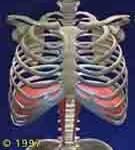

In her last comment, Ariadne brought up a common concern about Alexander Technique lessons causing over thinking or having to think about every single thing you do, maybe even every breath. The Alexander Technique does not encourage that and I don’t suggest trying it.
The Problem
Alexander suggests that we habitually use our bodies in a haphazard way that includes excess tension. In every action (like bending, singing, running), along with doing that action we also create excess tension that works against the action. This excess tension is generally intrinsic to everything we do because it is part of the haphazard fabric of how we use the body.
The Solution
In Alexander lessons, you don’t learn how to do things. Instead, you learn how to stop doing what is unnecessary. You pay less attention to the doing of the activity, and more attention to what is getting in your way. Habits can be very tangled, but as you learn, you can begin to pick out the bad and allow the good to take place on its own. It’s not as hard as it seems because we are made of one cloth and the same habits usually appear in everything we do. Activities may be different, but the habits that get in our way stay the same.
Don’t Learn to Breathe
Breathing is actually a good place to examine this issue. Although breathing is both a conscious and unconscious activity, the same habits of excess tension are with it all the time. In Alexander Technique lessons, you don’t learn how to breath so much as learn how to stop what gets in the way of your breathing so that you free the breath to take place on its own. Here is a link to an exercise and an mp3, Improve Your Breathing.
Breathing tomorrow.


I sometimes think you should rename your site freeyourbreath.com ! I have received so much benefit from all your tips and the mp3 on breathing. I find it more helpful than an emphasis on the neck ~ breathing is dynamic and central.
Thankyou so much. Joy
Hi Joy,
Thanks for your comment! Breath, of course, is vitally important. But in the body, everything works together and all the best is limited by the worst. Freedom in the neck, length in the spine, clarity in the hip joints – breathing is less good when all of that is compromised. And it really isn’t any more trouble to explore the whole rather than the part.
Another synonym of alex discovery@
if head compresses the torso(back), then the torso(back) compresses the limbs.
OR
if the limbs compresses the torso,
then the torso compresses the head or(the torso compresses by the head)
OR
The alexander technique is a ‘MASTER TOOL’to create the other tools(tailor made) for the benefit of the mindbody health.
I wont forget the sacrum spine. Since, ‘it is a part of spine, and it is a part of back lengthening process and goes back when the head goes forward and up and all other parts neck,torso(back),limbs are going towards alex directions with stimulus daily activities like sit,walk,bend etc’.
Paradox@ the ape thought the alexander directions for thousands of years and became human.
…..
Paradox@
1.The human structures of the body varies like fat,lean,stoop etc.
But, alex directions are same which are fundamental human movements .
2. (paradox)
We cant estimate a persons use, by seeing with our eyes, how he is using his/her body.
…
Examples of indirect procetures of alex@
1. A person walks 8 km/hour habitually for the past 10 years.
If he decreases or increases his speed 6km/hour or 12 km/hour for the next one year then,
he is working out indirectly using whole mind body.
What are other examples?
My new idea born by the alexander statement@
‘change involves against the habitual activities ‘-f.m.alexander
1. Are you walking with too much movement of arms.?
Change@move with less movement of arms.
2. Are you walking with too much distance between front and back leg?
A. What is the distance between front and back leg?
Change@ walk with less distance between the legs against the habit.
3.while standing habitually what is the distance between the feet?
And change it.
What are other examples of this type?
How alex directions happenning in these changes?
How these changes works?
The pelvis should be lengthen ,to lengthen the legs.
the chest should be lengthen , to lengthen the shoulders,arms.
The neck should be lengthen to lengthen the chest,pelvis.
The head should be lengthen to lengthen the neck , in our daily activities.
50-50 choices@
……
Doing 50 (9 hours out of 18)percent alexander directions
AND
not doing 50 percent(9 hours out of 18) alexander directions.
in my daily activity like sit,walk,stand,bend etc. (The remaing 6 hours for sleeping).
How this utter paradox works?
What is bad habit, how it synchronizes its tension to other muscles of the body?
Alexander finally found his habitual holding of feet on the ground ,arched feet,bend toes created undue tension and this tension synchronized, with the muscle tension of new use directions.
he found all the past years of work what he did was misdirected.
sorry, iam giving the command neck free head forward and up.
but
but
but
iam only doing up, not forward. so, iam very very far from my end.i failed
once again.
some how i have to practice thinking the alexander directions on a regular basis , while doing my office work in front of the computer and doing my daily activities like bathing,brushing ,walk,sit,bend.
i have to think two processes one is alexander process parallel to my daily activities. this will help for my health very well.
this will help for my health very well.
this will help for my health very well.
shall i paradoxically think,
the unconscious bad habitual part misdirects every part , which synchronizes its tension to the other parts with which iam trying to employee the new use.
i know the habitual bad part ,which has high tendency to misdirect every part .
what i have to do with that part?
ans: i will give the first preference to it in directing, linking to all other mechanisms of the body . so that, i make the bad habit part tension satisfactory, and synchronize this tension with the other parts
by remembering the alexander good directions of use and its principles.
You explanation is good.
An activity can be done
1. In one way
2. Or another way
3. Or not doing at all.
If i dont want to do it, i will stop thinking.
If i want to do it in one way i will think in that way.
If i want to do it another way i will think in that way .
Or i will do it my habitual way.
Thinking reasonings, what is good, bad.
What happens to what happens i think this may not be over thinking.